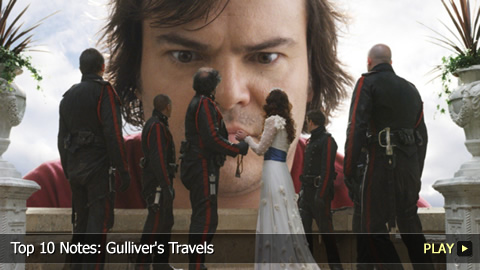Top 10 Notes: Gulliver's Travels

#10 – About the Author
Born in 1667 in Dublin, Ireland, Jonathan Swift was mainly brought up by his uncle after his father’s death. Following his university graduation, he worked as a diplomat’s secretary. Swift soon began writing satire, poetry and political works. Unfortunately, his physical and mental health worsened and he died in 1745.
#9 – Influences and Inspirations
“Gulliver’s Travels” was partially inspired by Swift’s involvement in English politics and his experiences with human nature. The book is considered a satire with elements of fantasy, and parodies the genre known as travellers’ tales. By presenting a somewhat negative view of humankind, Swift also challenged ideas from the Enlightenment era.
#8 – Settings and Era
Each part of the novel details one of Lemuel Gulliver’s voyages to various locations. While places like Lilliput, Brobdingnag, Laputa and the Country of the Houyhnhnms are fictional; Gulliver also visits Japan and England. Swift uses the make-believe locations for satirical purposes and political commentary.
#7 – Plot
The story follows Lemuel Gulliver’s voyages by sea. On his first trip, he lands on Lilliput where he meets people who are 6-inches tall. His second voyage takes him to Brobdingnag where the people can grow over 70-feet tall. Next, Gulliver finds himself on Laputa’s flying island. Before reaching Japan, he also visits the Balnibarbi mainland, the magician-filled Glubbdubdrib and Luggnagg with its aging immortals. On his last voyage, Gulliver experiences the land of the Houyhnhnms, where intelligent horses rule the primitive humans named Yahoos.
#6 – Lemuel Gulliver
As the novel’s narrator, Lemuel Gulliver is a smart Englishman with a background in medicine, navigation and mathematics. Thanks to his love of travelling and learning about people, he’s been on many different adventures. Readers easily relate to Gulliver in the beginning, because he’s honest, naïve and uses common sense to survive. As he becomes more arrogant, readers start taking him less seriously and laugh at his absurd actions. His curiosity and trip taking ultimately drive him crazy and cause him to reject others, especially human society.
#5 – The Lilliputians and Brobdingnagians
The Lilliputians are a tiny, small-minded, self-important, hypocritical people who are surprisingly dangerous despite their size. Ruled by an Emperor who’s reliant on low-heeled shoe wearers to make important decisions, they’re constantly at war and represent England’s political situation during Swift’s time. While Gulliver is large and potentially powerful in Lilliput, he’s powerless in Brobdingnag, where the people laugh at Gulliver’s weaknesses. Though the gigantic Brobdingnagians were Swift’s warning that larger forces could potentially end English dominance on the world stage, they’re mostly a peaceful people with simple laws and rules based on reason. Gulliver doesn’t feel safe or equal to them, despite their kindness.
#4 – The Laputians, Houyhnhnms and Yahoos
The Laputians are a people who use magnets to control their floating island home. They represent the dangers and limitations of abstract and theoretical knowledge, as these have made them oblivious to each other and all human concerns. Since the Laputian King harshly rules the island and the land below, one of the cities successfully revolts. This rebellion’s a symbol of Great Britain’s relations with Ireland. In the Country of the Houyhnhnm, Gulliver encounters horses that represent the strengths and flaws in reason, as they are smarter than the greedy, violent and dirty human-like creatures called Yahoos.
#3 – Values and Themes
One of the novel’s main themes is politics and whether a proper form of government exists, especially as related to the ideas of might versus right and the individual versus society. It explores the practical use of science, the limits of human understanding, how class and rank affect society, and the relationships between lies and the truth. Swift also appears to support a morality that favors loyalty and kindness over greed and dishonesty.
#2 – Modern Popularity
Published under a pen name in 1726, “Gulliver’s Travels” was an instant hit and has been in print for almost three centuries. While terms like Lilliputian and Yahoo have become English expressions, the novel itself has spawned multiple sequels.
#1 – Screen Adaptations
“Gulliver’s Travels”’ has been adapted for the screen on numerous occasions, including animated productions targeting children and a well-received live action TV series. In 2010, a fantasy comedy with the same name added a modern setting to the tale.
Do you agree with our list? What’s your favorite piece of “Gulliver’s Travels” trivia? Be sure to subscribe to WatchMojo.com for more entertaining top 10s.


 0
0
 0
0
 report
report